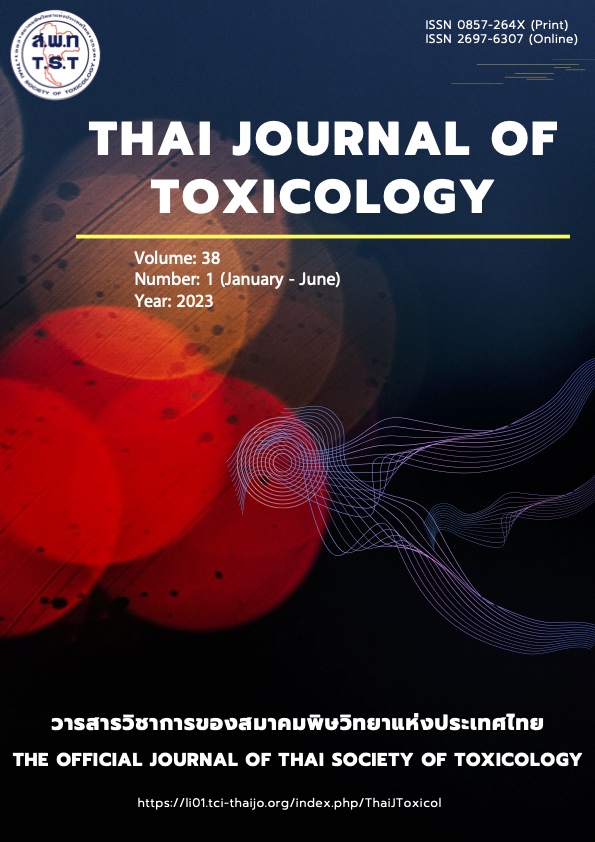Effects of 2,4-D Dimethylammonium and Ethanol Co - Exposure on Oxidative Stress and Toxicity in HepG2 Cells
Main Article Content
Abstract
2,4-D dimethylammonium is a popular herbicide used by farmers. Alcohol consumption is also popular in society, both of which can cause adverse effect on the liver. This study aimed to study the effects of combined exposure of 2,4-D dimethylammonium and ethanol on oxidative stress and cytotoxicity on HepG2 cell line. The HepG2 cells were cultured with 2,4-D dimethylammonium, ethanol or the combination of 2,4-D dimethylammonium and ethanol to investigate the inhibition of cell growth, occurrence of free radicals, activities of superoxide dismutase, catalase, glutathione peroxidase, reduced glutathione and malondialdehyde levels. The results showed that the combined exposure of 2,4-D dimethyl ammonium and ethanol resulting in increased cytotoxicity. There was an increase in intracellular oxidants. The activities of superoxide, dismutase, catalase, glutathione peroxidase also increased. The levels of malondialdehyde have increased while reduced glutathione was reduced compared to a single exposure. It was concluded that the exposure of comminated 2,4-D dimethyl ammonium and ethanol enhanced the intracellular oxidants. Therefore, this study shows that the combined exposure of 2,4-D dimethylammonium and ethanol enhanced the intracellular oxidants, which is the major cause of oxidative stress and cytotoxicity. The data from this study can be used as a guideline for animal studies and study of the toxicity trend have been combined exposure. It is also specified as a precaution for those who was used herbicides and alcohol.
Article Details
References
Hiran S, Kumar S. 2,4-D Dichlorophenoxyacetic Acid Poisoning; Case Report and Literature Review. Asia Pac J Med Toxicol. 2017; 6(1): 29-33.
สำนักงานสถิติแห่งชาติ. การสำรวจพฤติกรรมการสูบบุหรี่และการดื่มสุราของประชากร พ.ศ.2560, พิมพ์ครั้งที่ 1. กรุงเทพฯ: พิมพ์ดีการพิมพ์, 2561: 31-45.
Gunness PF. The Effect of 2,4-D on gene expression in cultured cells. (Master’s Thesis). Saskatoon: University of Saskatchewan, 2007: i-204.
Chen W, Shaw L, Chang P, et al. Hepatoprotective effect of resveratrol against ethanol-induced oxidative stress through induction of superoxide dismutase in vivo and in vitro. Exp Ther Med 2016; 11: 1231-8.
Abnova. MTT Assay [Video], 2010. Available at https://www.youtube.com/watch?v=vn6en A6lSKs, accessed on April 8, 2020.
Chou TC, Talalay P. Quantitative analysis of dose-effect relationships: the combined effects of multiple drugs or enzyme inhibitors. Adv Enzyme Regul 1984; 22: 27-55.
จิราภรณ์ รังผึ้ง, รัชนี คงคาฉุยฉาย, สุจิรา มุกดา และคณะ. ผลของสารสกัดแอลกอฮอล์ของมะขามหวานและกล้วยไข่ต่อการเกิดพิษจากสารไฮโดรเจนเปอร์ออกไซด์ในเซลล์ประสาทมนุษย์ชนิด SH-SY5Y. วารสารพิษวิทยาไทย 2561; 33(2): 63-81.
Mahakunakorn P, Tohda M, Murakami Y, et al. Effects of Choto-san and Its Related Constituents on Endogenous Antioxidant Systems. Biol Pharm Bull 2005; 28: 53-7.
Buraphaka H, Putalun W. Stimulation of Health-promoting triterpenids accumulation in Centella asiatica (L.) Urban leaves triggered by postharvest application of methyl jasmonate and salicylic acid elicitors. Ind Crops Prod 2020; 146: 112171.
Adeyemi JA, Martins-junior AC, Barbosa FJ. Teratogenicity, genotoxicity and oxidative stress in zebrafish embryos (Danio rerio) co-exposed to arsenic and atrazine. Comp Biochem Physiol 2015; 7–12.
Tadee A, Mahakunakorn P, Porasuphatana S. Oxidative stress and genotoxicity of co-exposure of chlorpyrifos and aflatoxin B1 in HepG2 cells. Toxicol Ind Health 2020; 1-10.
Armstrong D, Browne R. The analysis of free radicals, lipid peroxidases, antioxidant enzymes and compounds related to oxidative stress as applied to the clinical chemistry laboratory. Adv Exp Med Biol. 1994; 366: 43-58.
Tuschl H, Schwab C. Cytotoxic effects of the herbicide 2,4- dichlorophenoxyacetic acid in HepG2 cells. Food Chem Toxicol 2003; 41(3): 385-93.
Zhang Y, Wang C, Yu B, et al. Gastrodin Protects against Ethanol-Induced Liver Injury and Apoptosis in HepG2 Cells and Animal Models of Alcoholic Liver Disease. Biol Pharm Bull 2018; 41(5): 670-9.
Bradberry SM, Watt BE, Proudfoot AT, et al. Mechanisms of toxicity, clinical features, and management of acute chlorophenoxy herbicide poisoning: A review. J Toxicol Clin Toxicol. 2000; 38(2): 111–122.
Teixeira MC, Telo, JP, Duarte NF, et al. The herbicide 2,4-dichlorophenoxyacetic acid induces the generation of free-radicals and associated oxidative stress responses in yeast. Biochem Biophys Res Commun 2004; 324: 1101-7.
Carrasco D, Carrasco C, Souza-Mello V, et al. Effectiveness of antioxidant treatments on cytochrome P450 2E1 (CYP2E1) activity after alcohol exposure in humans and in vitro models: A systematic review. Int j food prop 2021; 24: 1300-17.
ตรีทิพย์ รัตนวรชัย. พิษแอลกอฮอล์เชิงชีวเคมี. ธรรมศาสตร์เวชสาร 2557; 14(3): 405–30.
Flora SJS. Structural, chemical and biological aspects of antioxidants for strategies against metal and metalloid exposure. Oxid Med Cell Longev. 2009; 2(4): 191-206.
Shafeeq S, Mahboob T. 2,4-Dichlorophenoxyacetic acid induced hepatic and renal toxicological perturbations in rat model: Attenuation by selenium supplementation. Toxicol Ind Health 2021; 37(3): 152-63.
Ogony J, Matthews R, Anni H, et al. The mechanism of elevated toxicity in HepG2 cells due to combined exposure to ethanol and ionizing radiation. J Appl Toxicol 2008; 28(3): 345-55.
Goldstein DB. Effect of alcohol on cellular membranes. Ann Emerg Med 1986; 15(9): 1013-8.
Mehmood Z, Williamson MP, Kelly DE, et al. Human cytochrome P450 3A4 is involved in the biotransformation of the herbicide 2,4-dichlorophenoxyacetic acid. Environ Toxicol Pharmacol 1996; 2(4): 397-401.
Bradberry SM, Vale JA. Chlorophenoxy Herbicides. Critical Care Toxicology 2017; 1789–96.
Paoli A. Ketogenic diet for obesity: friend or foe? Int J Environ Res public health 2014; 11(2): 2092–107.


